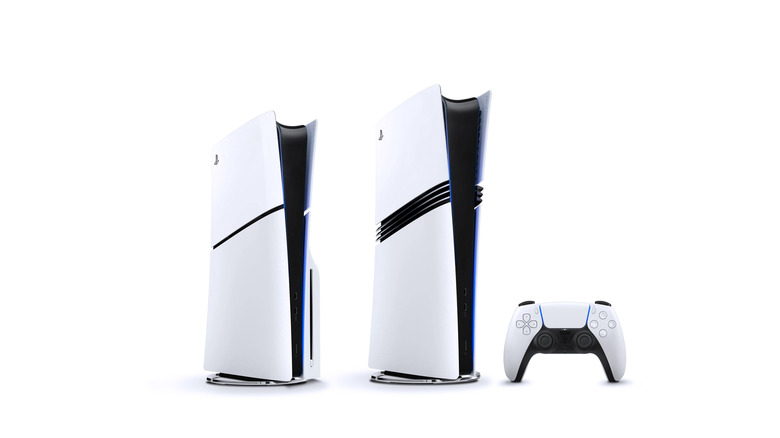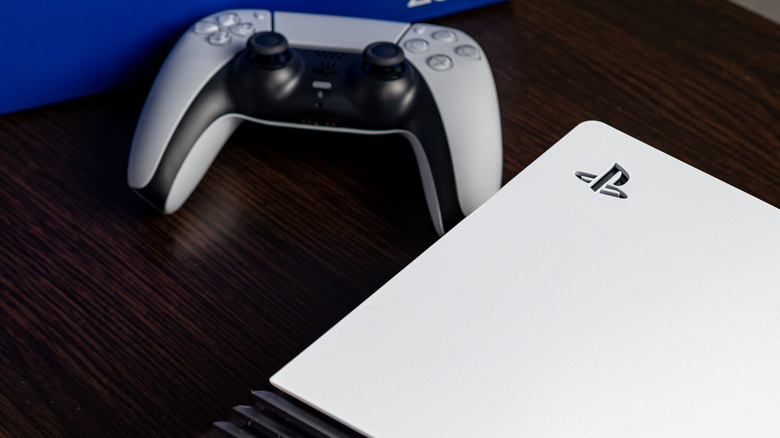What's The Difference Between The PlayStation 5 Pro And Slim Consoles?
We may receive a commission on purchases made from links.
If you're in the market for a PlayStation 5, you have two models to choose from: the PS5 Slim and the PS5 Pro. (The PS5 Slim also gives you a choice between disc and digital, but we'll get to that in a bit.) The Slim and the Pro are both updates to the original 2020 console, but neither is exactly a generational leap — they're more like the PlayStation 5 1/2, Side A and Side B.
The Slim redesigns the form factor of the launch model PS5, while the Pro is a full-fledged hardware upgrade with improved performance over both the Slim and the launch model. You can't see improved performance from the outside, though, which means the most obvious visual difference is the size.
The Slim is around 30% smaller by volume than the original PS5, but it maintains the same basic design and still comes in both disc and digital versions. The disc drive is also available to buy as an add-on for digital console owners who want the best of both worlds. The PS5 Pro is a little less wide than the original PS5, sure, but it's hardly slim — even as a digital-only console. (Again, those who want the disc drive have to buy it separately.)
How the Pro and the Slim's hardware compares
Internally, the PlayStation 5 Slim comes with a 1TB solid-state drive, while the Pro comes with 2TB. Both support USB expansion and Samsung's NVMe SSD upgrades, but the PS5 Slim has the same processor and GPU architecture as the launch model. It also has no significant changes to performance or graphical output.
This is where the PS5 Pro really soars: It features a GPU with 67% more compute units and faster memory bandwidth than any other PS5 model, giving it more consistent high-resolution performance, better ray tracing, and support for PlayStation Spectral Super Resolution (PSSR), Sony's new AI upscaling feature.
Both consoles come with the PS5's new DualSense controller with support for 3D audio, haptic feedback, and adaptive triggers. Backward compatibility with the PlayStation 4 is also available on both systems, but the PS5 Pro supports more titles: The Slim only supports around 4,000 titles, while the Pro is compatible with over 8,500.
Little things that set the two PS5 models apart
The PlayStation 5 Pro has another leg up over the PS5 Slim, and that's its connectivity. The Pro supports the newer IEEE 802.11be wireless standard Wi-Fi 7, which gives it higher transfer speeds and would ideally reduce latency (so long as your router's compatible with the standard). The Slim supports the same standards as the original PS5, which includes Wi-Fi 6. Even so, both models have four USB ports and HDMI 2.1 output for 4K and 120Hz displays.
Looking at the two from above, it's clear the PS5 Slim and PS5 Pro represent two different strategies for the console ahead of the next-gen PlayStation 6 in 2027 or later. The Slim replaces the original model, reducing the size and physical footprint of the standard PS5 without changing its core technical specs or $499 price tag. The Pro adds new hardware capabilities for better graphics and smoother frame rates, but also carries a higher cost of $699 and lacks a dedicated disc version.
Choosing between the two comes down to what matters more to you: compact design and baseline performance at a lower cost (Slim), or improved visuals and expanded feature sets at a truly steep price (Pro). Either way, you're in for some awesome gameplay.


